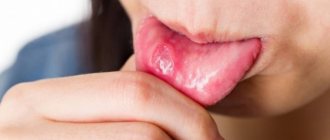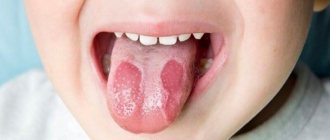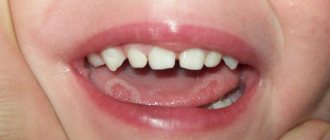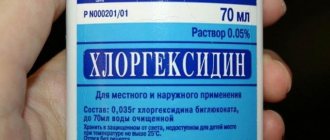Stomatitis, which occurs in the human oral cavity, is a fairly common disease not only among children, but also among adults. This disease manifests itself in the form of single or group rashes of various types on areas of the mucous membrane in a person’s mouth, as well as on the tongue.
Stomatitis formations on the tongue cause the greatest discomfort in a person, since the disease in this case is certainly accompanied by pain not only when eating or talking, but even when making swallowing movements. Therefore, this problem requires an immediate and urgent solution. The LeaderStom network of dental clinics invites you to learn more about how to cure stomatitis on the tongue and eliminate the causes of this disease.
Types of disease
According to ICD-10, aphthous stomatitis is assigned code K.12. Within the code there are three qualifying diagnoses, including K.12.0 - “recurrent aphthae of the oral cavity,” which also includes aphthous ulcers.
According to the form of occurrence, acute and chronic aphthous stomatitis are distinguished. The first is characterized by the appearance of ulcers and severe hyperemia - swelling, redness of the mucous membranes. Severe pain occurs, especially when eating or talking. Submandibular lymph nodes may enlarge and body temperature may rise.
Chronic recurrent aphthous stomatitis may be the result of improper or untimely treatment, as well as the inability of the immune system to cope with the disease. It is characterized by periodic exacerbations. Outside of exacerbation, symptoms may be erased or completely absent.
The disease is classified into three forms depending on the severity:
- light. From 1 to 2 afts up to 10 mm in size. Moderate pain during mechanical action, relapses occur no more than 2 times a year;
- average. Up to 5 aft, the course of treatment takes up to 3 weeks. The pain is quite pronounced, there is an enlargement of the lymph nodes, relapses up to 2 times a year;
- heavy. Multiple aphthae appear, severe pain. An increase in temperature occurs, and symptoms of general intoxication appear. Treatment takes up to a month, relapses occur up to 6 times a year.
Also, according to the form of occurrence, the following types of inflammatory diseases are distinguished:
- fibrous: blood microcirculation in the upper layer of the mucosa is disrupted, aphthae appear, covered with a fibrous film (plaque). Such ulcers heal completely within 14 days. The disease affects the mucous membrane of the lips, the lateral surfaces of the tongue, and transitional folds. This stomatitis recurs up to 3 times a year;
- necrotic. The epithelium is destroyed, the mucosal area dies. Replacement of tissues with normal epithelium takes from 14 to 30 days. This aphthous stomatitis is not accompanied by acute pain; it is usually observed in patients with severe diseases, including blood pathologies;
- grandular. Damage to the ducts of the minor salivary glands occurs. In this regard, aphthae form close to the glands, and drying of the mucous membranes of the oral cavity occurs due to a decrease in saliva production. Ulcerations are painful and heal within 1–3 weeks;
- scarring. Damage to the cavity of the salivary glands leads to the involvement of connective tissue in inflammation. Aphthae are observed both at the location of the glands and on the mucous membranes of the pharynx and palate. The disease develops into large painful ulcers (up to 1.5 cm). Healing takes up to 12 weeks; after the acute process, pronounced scars remain;
- deforming. The most severe form of the disease, which provokes changes in connective tissue. Aphthae heal extremely slowly, which is accompanied by deformation of the palate, lips, and sometimes narrowing of the oral cavity occurs (if aphthae was observed in the corners of the mouth).
Ask a Question
Stomatitis: how to overcome the “language barrier”?
Stomatitis on the tongue is just one of the manifestations of this “popular” disease. There are a huge number of reasons for its appearance, as well as ways to treat it.
There are several types of stomatitis, when it manifests itself specifically on the tongue: glossitis, viral stomatitis, vesicular stomatitis, enteroviral vesicular stomatitis, catarrhal stomatitis, fungal stomatitis, etc.
In general, stomatitis on the tongue is most common. Its notable feature is small ulcers, from which the patient suffers greatly. If inflammation is observed only on the tongue, and, for example, there are no signs of stomatitis on the palate, cheek or gum, then this disease is called glossitis.
Causes of aphthous stomatitis
Not all causes of aphthous stomatitis are fully understood. The mechanism of aft formation is often associated with activation of the local immune system - immune cells begin to destroy the epithelium of the mucous membranes, which leads to ulcers.
Local reasons include the following:
- allergic reactions;
- pathogenic microorganisms;
- mechanical damage (biting mucous membranes, injury from sharp edges of fillings or orthopedic, orthodontic structures);
- temperature or chemical influences.
Systemic causes of aphthous stomatitis:
- menstruation, pregnancy in women;
- sudden cessation of smoking;
- enteropathy, celiac disease, malabsorption;
- blood diseases;
- diseases of the immune system;
- lack of vitamins;
- other systemic diseases (lupus erythematosus, Crohn's disease, HIV infection, etc.).
Prevention in infants
Preventive measures should begin in a newborn child immediately after he is discharged from the maternity hospital. For the first days and months of life, it is necessary to adhere to thorough disinfection of toys, bottles during artificial feeding, or to treat the nipples immediately before applying to the breast.
«
An important point is regular visits to the dentist from the first teeth. It is necessary to carefully care for your baby’s oral cavity and use only special toothbrushes and toothpastes, preferably those recommended by the doctor.
Symptoms of aphthous stomatitis
Usually, 1–2 days before the appearance of aphthae, areas of the mucous membrane with increased sensitivity are detected, and a burning sensation may occur. The aphthae themselves are round, have clear boundaries, and are covered with a gray or yellowish coating. Their size, as a rule, does not exceed 1 cm, and the mucous membranes around them turn red.
Such areas of erosion heal within up to 2 weeks without scarring. But in 1 case out of 10, the diameter of the ulcers is more than 1 cm, they affect deeper areas of tissue, and the borders of the pathological area may look raised. Healing in this case takes up to 6 weeks, after which a scar forms.
Aphthous stomatitis is characterized by damage to the mucous membranes of the cheeks, the inside of the lips, the soft palate, tonsils, and the lateral surfaces of the tongue. This is due to the lack of keratinization of the epithelium in these areas. Much less often, aphthae appear on the hard palate, back of the tongue, and gums.
Why does it occur
Stomatitis on the tongue is caused by bacteria, viruses, and fungi that live in the oral cavity. These can be pathogenic and conditionally pathogenic microorganisms that begin to actively multiply as a result of decreased immunity or jaw injuries.
Any person has a huge number of bacteria on the mucous membranes of the tongue. Under normal conditions, they do not cause harm and do not cause any complications. This is due to the fact that saliva contains a special antiseptic component - lysozyme, which does not allow bacteria to actively spread.
With a decrease in the body's defenses and trauma to the tissues of the tongue, infection occurs. Lysozyme ceases to cope with the function of suppressing bacterial and viral agents. Then wounds appear that do not heal for a long time.
Infectious lesions of the mucous membranes
The human tongue is an ideal place for bacteria and viruses to multiply. But saliva exhibits harmful activity and does not allow the latter to spread. If the salivary glands do not function at full capacity, the content of harmful organisms increases. This happens with diabetes, dysbiosis, and severe dehydration.
If there are too many bacteria, a white or yellowish coating forms on the tongue. Soon, ulcers of an infectious nature form. Bubbles can also form, which burst and merge with each other, turning into voluminous painful erosions.
Injuries as a provocateur of illness
In some people, stomatitis is a consequence of constant trauma to the membranes of the mouth from the braces. Damage can also be a consequence of an incorrect bite - for example, if, due to an anomaly, a person very often bites the tip of his tongue.
It has been noticed that the disease more often develops in people who eat solid foods that have sharp edges (lollipops, crackers, etc.). Injury to mucous membranes and broken crowns of teeth.
Poor oral hygiene is a contributing factor to the problem.
More often, people who do not pay due attention to oral hygiene need treatment. Typically, they rarely brush their teeth, do not undergo routine dental examinations, and do not use dental floss or mouthwash.
It is very bad if a person eats unwashed vegetables and fruits or has the bad habit of biting nails and foreign objects. All this aggravates the already imperfect hygiene and increases the risk of infection of microcracks on the surface of the tongue.
Diseases of the gastrointestinal tract are the culprits of stomatitis
You can tell a lot about the features of the gastrointestinal tract by looking at the language. If the mucous membrane of an organ often becomes inflamed and becomes painful, doctors suspect the presence of ulcers, gastritis, colitis, etc.
In such a situation, self-medication is prohibited. The patient needs to consult both a dentist and a gastroenterologist.
Stomatitis as a symptom of helminthic infestation
The studies carried out made it possible to establish that tissue irritation is sometimes the result of the activity of worms living in the human body. The presence of worms can be suspected if the tissues of the oral cavity are covered with small ulcers at intervals of thirty to forty days.
Allergy is the cause of the disease
In allergy sufferers, inflammatory mouth disease is more common. Relapses occur after using certain foods, cosmetics, medications, toothpastes and various hygiene products.
If there is an assumption that the disease is a consequence of individual intolerance to any compound, the use of any formulations containing it should be excluded. During periods of exacerbation, it is necessary not only to relieve inflammation that appears in the mouth, but also to take antihistamine tablets prescribed by an allergist.
Intoxication causes illness
In some people, the disease appears in response to poisoning by some toxic elements. Sometimes one dose of a poisonous drug is enough to then suffer from relapses for a long time.
Intoxication occurs when inhaling fumes of paint, varnish, low-quality household chemicals, or after using a number of building materials. People who work with chemical fertilizers, dangerous cleaning solutions and gels are especially at risk of encountering it.
Diagnostic features
At the initial appointment, the dentist examines the oral cavity and analyzes complaints. To make an accurate diagnosis, you need to distinguish this form of the disease from others, as well as differentiate it from other pathologies that have similar symptoms. For extensive lesions, different diagnostic methods may be used:
- clinical blood tests;
- microflora smear;
- blood for PCR to determine the causative agent of the disease;
- biopsy (if indicated).
They are also necessary for recurrent forms of the disease. In simple cases, laboratory diagnostics are not required; aphthae are determined visually by an experienced specialist.
With the help of a comprehensive examination, the doctor will determine which microorganism caused inflammation with subsequent ulceration of the mucous membrane. He also differentiates the disease from herpetic stomatitis and oncological pathology.
Diagnosis
It is difficult to independently distinguish relatively harmless manifestations of diseases in the form of red spots from serious disorders. Any rash on the tongue already indicates systemic problems, but some of them indicate serious cases.
Erythroplakia requires immediate surgical intervention. Therefore, it is better not to take the position “it will go away on its own,” but to consult a doctor.
Since spots on the tongue are a symptom of disease, examination is usually aimed at identifying the causes. Laboratory tests, flora tests, histology and medical history allow us to make the correct diagnosis and prescribe appropriate treatment.
Features of treatment
The main goal of treating aphthous stomatitis is to completely get rid of the disease or at least reduce the frequency of relapses to a minimum. Therapy is aimed at relieving inflammation, relieving unpleasant symptoms, and accelerating the recovery processes of the mucous membrane.
For each specific case, the doctor will develop a set of measures. The main ones include local and systemic drug treatment.
Rinsing with antiseptics can be done using medications or mouth rinses that contain antibacterial components. An alternative to rinsing is to use a spray. Typically, the treatment regimen includes 2-3 sessions of 1-minute rinsing immediately after brushing your teeth.
Local treatment methods include the application of gels with anti-inflammatory and analgesic effects.
Occlusive agents can reduce pain and speed up the healing of mucous membranes. They form an insoluble film on the ulcer, protecting the affected area from exposure to adverse factors.
Local glucocorticoid therapy is used against the background of immune diseases, as well as when standard measures are ineffective. They eliminate pain and quickly relieve inflammation, shortening the healing period. Such products are used only according to indications and are available with a prescription. In some cases, it is advisable to inject the drug under the base of the ulcer; this is done by a doctor.
Epithelialization drugs are used after acute inflammation has resolved. The specialist will prescribe a gel with an analgesic and healing effect, usually this occurs 5–6 days after the start of complex therapy.
Local laser therapy can relieve pain, speed up the healing process, and minimize the risk of relapse.
Systemic treatment of aphthous stomatitis in adults involves taking the following drugs:
- antihistamines (anti-allergic, anti-edematous effect);
- glucocorticoids (anti-inflammatory, analgesic effect);
- immunomodulators (to stimulate defenses and accelerate recovery).
And if antiallergic drugs can be recommended to any patient even in the absence of information about the exact causes of stomatitis, then other drugs are prescribed only according to indications: in case of acute severe course of the disease, frequent relapses, and the presence of severe systemic pathologies. An additional method of treatment is vitamin therapy - taking vitamins C, group B.
In addition to the main course of treatment, all patients without exception are recommended to adhere to a hypoallergenic diet, avoid taking too hot drinks and dishes, and spicy, irritating foods. It is better to give preference to toothpaste without sodium lauryl sulfate, this component can provoke the disease.
It is important to continue your oral hygiene, even if it is difficult. To make brushing your teeth easier, choose a soft toothbrush. If the disease recurs frequently, it is necessary to pay attention to the general state of health, promptly treat teeth and gums, replace fillings and dental structures.
Treatment at home
It is quite possible to cure stomatitis using home remedies. A decoction of chamomile or calendula is suitable as a pain reliever. Aloe and Kalanchoe juices help speed up the healing process. They need to treat ulcers 2-3 times a day.
Herbal solutions for rinsing should be brewed in boiling water. Take a spoonful of dry herbs for a glass of water. Be sure to infuse the solution for an hour and filter after cooling. You need to rinse with herbal infusion more than three times a day.
Traditional recipes for stomatitis:
- Hydrogen peroxide. Regular rinsing with this substance helps relieve pain. You need to dilute a teaspoon of peroxide in boiled water and gargle three times a day.
- Propolis. A tincture with an alcohol solution of propolis can relieve inflammation. You should dilute a spoonful of the solution in ½ glass of water. The effectiveness of this treatment can be increased by alternating with rinsing with peroxide.
- Aloe, Kalanchoe. Two more good remedies for inflammation. It is recommended to rinse your mouth with a solution of freshly squeezed juice from time to time or chew plant leaves.
- Garlic. This is a unique bactericidal agent that is good for stomatitis. You need to chop a few cloves of garlic and mix with fresh homemade sour cream. It is enough to keep the mixture on your tongue for 30 minutes several times a day.
- Potato. In the fight against stomatitis, you can use slices of raw potatoes or gruel.
- Carrot juice. Fresh carrot juice diluted with water is good as a gargle for tongue ulcers. It is necessary to carry out the procedure three times a day.
- Cabbage juice. Use in the same way as carrots.
- You can relieve pain from stomatitis with a solution of furatsilin or a weak solution of potassium permanganate.
Traditional medicine offers wound treatment products, decoctions, infusions and fresh plants. The advantage of the therapy is its naturalness, the absence of dyes and artificial additives. This is also a disadvantage, because the plant origin of natural ingredients can provoke allergies in the patient.
Herbal infusions
Many patients with stomatitis are helped by infusions and decoctions of medicinal herbs. In this case, the following plants are recommended:
- St. John's wort;
- anise;
- sea buckthorn;
- chamomile;
- sage;
- verbena;
- Eryngium flatifolia;
- horseradish;
- currant berries;
- calendula;
- bergenia;
- raspberries;
- Oak bark;
- Potentilla erecta;
- blackberry leaves.
All infusions can be prepared according to the same scheme: mix two teaspoons of herbs thoroughly, pour three glasses of boiling water, leave (preferably for several hours). You need to rinse your mouth with warm infusion. The course of herbal treatment is 10 days.
Recipes for stomatitis with herbs and available ingredients:
- Anise helps well with catarrhal and ulcerative lesions of the tongue. You need to steep a tablespoon of anise in a glass of boiling water for half an hour. Recommended for rinsing three times a day.
- An infusion of chamomile, calendula, verbena, bergenia and oak bark is also effective for stomatitis. You can only take those herbs that are available. The mixture must be poured with hot water and processed in a water bath for 15 minutes. Leave for 1-2 hours. This collection quickly copes with inflammation, relieves pain and disinfects the mouth.
- Safe methods for treating stomatitis at home include solutions with the juice of Kalanchoe, carrots and cabbage. These juices, diluted with water, are effective as a rub on ulcers and as a rinse throughout the mouth.
- For severe stomatitis, you can try stronger recipes. Ulcers can be lubricated with a mixture of novocaine (1 ampoule), vegetable oil (teaspoon), honey (teaspoon), and one egg white.
- Advanced stomatitis should be treated with a decoction of onion peels. For 100 g of husk you need to take 0.5 liters of water. Boil the broth for 15 minutes, then leave for 6-8 hours, strain. Then add boiled water equal to the amount evaporated. You need to drink the decoction warm three times a day.
Such treatment of stomatitis should be combined with the consumption of foods enriched with vitamins A, B, C, E.
Treatment with herbal infusions will be effective only with regular use. You should rinse your mouth three times a day with warm solutions. It is necessary to continue treatment even after the symptoms subside (a few more days), since the infection is not destroyed when the manifestations are eliminated.
Traditional recipes for stomatitis in children
Infants very often suffer from fungal stomatitis. The child becomes infected with infections through the pacifier and during feeding. If your baby has a whitish coating on the tongue and the inner surface of the cheeks, you need to take appropriate measures without delay. Sometimes, during an infection, the baby may refuse to breastfeed, which should attract the mother's attention.
There are very few safe remedies for stomatitis in children:
- You can use a soda solution: dissolve a dessert spoon of soda in a mug of water and lubricate pacifiers, toys and the mother's breast with it before feeding.
- Infants can be treated with a decoction of chamomile or calendula. Also, steam a dessert spoon of herbs in a glass of boiled water and leave for a couple of hours.
- For older children, rosehip or peach oil, flaxseed oil, and Kalanchoe juice are suitable. They can treat wounds.
- If the child already knows how to rinse his mouth properly, you can use a solution with protein: mix half a glass of water and egg white. You need to rinse three times a day.
- You can treat a 6-7 year old child for stomatitis using safe carrot or cabbage juice or potatoes.
- In severe cases, you can prepare a stronger remedy. You need to take a dessert spoon of birch leaves, two spoons of sage, three spoons of rose hips and a spoon of oregano. You are supposed to pour boiling water over everything and leave for a couple of hours. After settling, mix the solution with kombucha and leave for another three days. To achieve improvement in the child's condition, rinsing three times a day is required.
Features of treatment in children
The dentist will tell you how to treat aphthous stomatitis in a child. You can contact him at the direction of your pediatrician or on your own if you find characteristic ulcers in the oral cavity. The treatment regimen is the same as that used in the treatment of adult patients, but there are some differences: children under a certain age cannot rinse the mouth, so preference is given to drugs for application to mucosal ulcers. Otherwise, the treatment regimen is developed individually, taking into account the severity, symptoms of the disease, frequency of relapses, and the presence or absence of concomitant ailments in the child. Symptomatic therapy can be used to quickly alleviate the baby’s condition.
Specialists at STOMA clinics successfully treat aphthous stomatitis. By contacting us, you will receive qualified assistance, detailed recommendations on the treatment and prevention of relapse of the disease, and comprehensive assistance from dentists of all specializations, if necessary.
Symptoms and signs
How to recognize stomatitis in children? Despite the abundance of causes that cause this disease, all forms of stomatitis have common clinical symptoms:
- The first signs of such a pathology are slight redness on the mucous membranes, which can be localized both on the gums and on the palate, on the tongue or on the lip.
- Gradually, the redness gives way to swelling, round or oval ulcers appear, covered with a whitish or gray coating on top and surrounded by a red cushion. These ulcers are very painful and prevent the child from leading a normal life, eating or sleeping.
- As the inflammatory process becomes more severe, small ulcers merge into one large one.
- Local signs of stomatitis are accompanied by general symptoms: the child’s temperature rises, weakness, and lack of appetite appear.
One of the features of the course of the disease is the appearance of vomiting with stomatitis. It is caused by increased work of the salivary glands and increased excitability of the baby’s nervous system due to severe pain.
PATHOGENESIS OF HERPETIC STOMATITIS
The pathogenesis of herpetic stomatitis is quite complex and not fully understood. It is not fully explained by what factors the inner shell of the virus is dissolved, what viral factors allow it to penetrate DNA - human cells, and why the virus, when it is inactive (that is, there are no clinical manifestations) cannot be treated.
However, scientists believe that at the time of infection, the herpes simplex virus attaches to specific receptors on the cell membrane (cells that are sensitive to HSV). Then the fusion of the cell membrane and the outer shell of the virus occurs. At the moment of such penetration, the cell membrane of the cell is not damaged, but the virus seems to bud inside. Then cellular enzymes work, those that dissolve the inner shell of the virus and the “naked” virus penetrates the DNA of the host cell. And the herpes simplex virus can remain in this state for a long time until the provoking factors work.
FACTORS PROVOKING RECURRENCE OF HERPETIC STOMATITIS
Factors that provoke relapse of herpetic stomatitis represent a large group. In principle, herpes can be triggered by anything, from climate change and time zone to ARVI and other infections. And so, the group of factors that provoke a relapse of herpetic stomatitis includes:
- Any change in body temperature (hypothermia is more favored by the herpetic stomatitis virus);
- Decreased immunity (any infection, etc.);
- Trauma to mucous membranes and skin;
- Stress, overwork or overexertion;
- Consumption of alcoholic beverages;
- Smoking;
- Menstruation;
- Change of climate and time zone;
- Taking medications.
As you can see from the lists, there are many factors, and the virus is just waiting for the body to give up. Children from 6 months to one year get sick due to the cessation of protective proteins from the mother. Therefore, let's talk about the prevention of herpetic stomatitis.
ETIOLOGY OF HERPETIC STOMATITIS
The etiology of herpetic stomatitis is simple. If there is a virus, there are diseases. The virus that causes herpetic stomatitis belongs to the HERPES VIRIDAE family. This family includes about 80 different viruses, and, note, 8 of which cause human illness. Herpetic stomatitis is caused by the herpes simplex virus type 1 (HSV-1), and if it was a congenital or intrauterine (neonatal) infection, then this infection occurred with the herpes simplex virus type 2 (HSV-2).
It would seem that the virus is simple - the infection is simple. But the herpes simplex virus itself is very cunning and insidious. This virus, the herpes simplex virus, has come up with 4 ways of entering the human body:
- Airborne (therefore, it is recommended to avoid people with visible manifestations of the virus);
- Contact (lips affected by herpes are unlikely to give pleasant kisses);
- Transplacental (that is, from mother to child);
- Transfusion (with blood transfusion).











